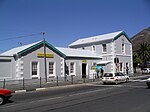SAS Good Hope

SAS Good Hope (pennant number: F432) was one of three Loch-class frigates in the South African Navy (SAN). It was built as HMS Loch Boisdale (K432) for the Royal Navy during World War II, but was transferred to the SAN before completion in 1944 and renamed as HMSAS Good Hope. The ship was assigned to convoy escort duties in 1945, but did not encounter any enemy ships before the end of the war. It was assigned to ferry troops home from Egypt afterwards and made port visits in Middle Africa in 1948. Upon returning home, Good Hope was placed in reserve until it was converted into a training ship during the mid-1950s and served as the navy's flagship. The ship was again placed in reserve in 1965 and was sold for scrap in 1977. Good Hope's remains were donated for use as an artificial reef and it was scuttled the following year.
Excerpt from the Wikipedia article SAS Good Hope (License: CC BY-SA 3.0, Authors, Images).SAS Good Hope
Geographical coordinates (GPS) Address Nearby Places Show on map
Geographical coordinates (GPS)
| Latitude | Longitude |
|---|---|
| N -34.2683 ° | E 18.4808 ° |
Address
Miller's Point
7995 , Miller's Point
Western Cape, South Africa
Open on Google Maps











